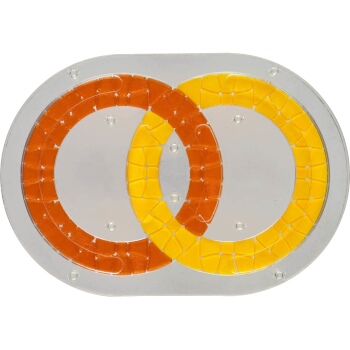
Above:Solved
Click a thumbnail to see its larger version and description.
Two intersecting rings (not circles) of pieces turning in steps of eight. A jumbling puzzle.
Alpha Pavonis (α Pavonis, abbreviated Alpha Pav, α Pav), formally named Peacock /ˈpiːkɒk/, is a binary star in the southern constellation of Pavo, near the border with the constellation Telescopium.
The historical name Peacock was assigned by Her Majesty's Nautical Almanac Office in the late 1930s during the creation of the Air Almanac, a navigational almanac for the Royal Air Force. Of the fifty-seven stars included in the new almanac, two had no classical names: Alpha Pavonis and Epsilon Carinae. The RAF insisted that all of the stars must have names, so new names were invented. Alpha Pavonis was named "Peacock" ('pavo' is Latin for 'peacock') whilst Epsilon Carinae was called "Avior".
At an apparent magnitude of 1.94, this is the brightest star in Pavo. Based upon parallax measurements, this star is about 179 light-years (55 parsecs) distant from the Earth. It has an estimated six times the Sun's mass and 6 times the Sun's radius, but 2,200 times the luminosity of the Sun.
Stars with the mass of Alpha Pavonis are believed not to have a convection zone near their surface. Hence the material found in the outer atmosphere is not processed by the nuclear fusion occurring at the core. This means that the surface abundance of elements should be representative of the material out of which it originally formed. In particular, the surface abundance of deuterium should not change during the star's main sequence lifetime. The measured ratio of deuterium to hydrogen in this star amounts to less than 5 × 10−6, which suggests this star may have formed in a region with an unusually low abundance of deuterium, or else the deuterium was consumed by some means. A possible scenario for the latter is that the deuterium was burned through while Alpha Pavonis was a pre-main-sequence star.
α Pavonis A is a spectroscopic binary consisting of a pair of stars that orbit around each other with a period of 11.753 days. However, in part because the two stars have not been individually resolved, little is known about the companion except that it has a mass of at least 0.26 M☉.
For the inventor it is a more complicated version of his Avior. See the seperate entry.
Size: 120 x 172 mm
Weight: 105 grams
Links

Contributors
No one has contributed to this page yet!
Collections
No one has added this puzzle to a collection yet!
Found a mistake or something missing?
Edit it yourself or
contact the moderator.



